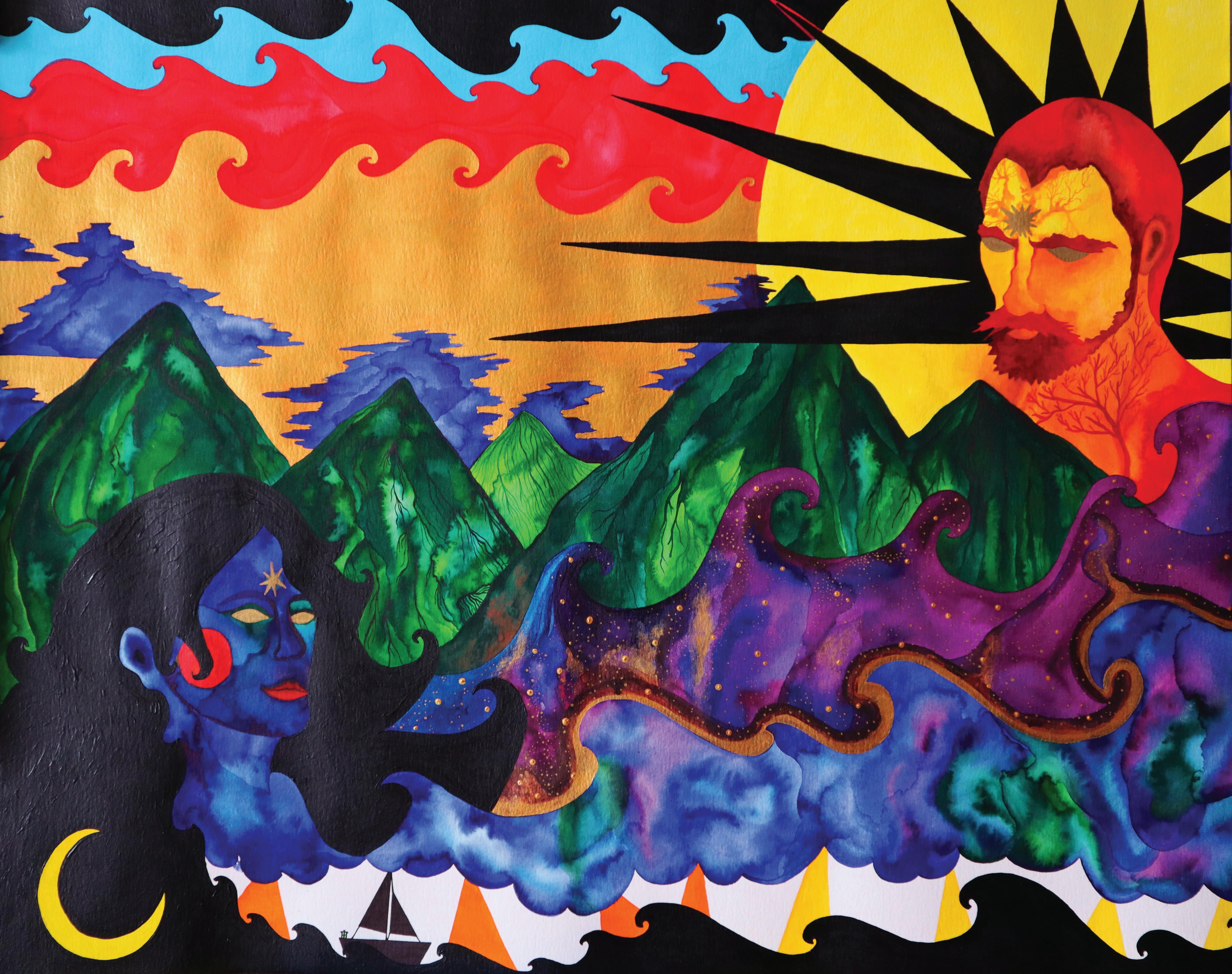
6 minute read
The Absurdist History of the Mermaid
Image + Words Nahum Gale
The ocean – a vast and endless world unto its own – home to Darwinian marvels and scientific phenomena that have continued to capture the imagination of land dwellers for millennia. In all its mysterious depths and evolving line of creatures, the infinite sea has played host to a plethora of tall tales and folklore. Although none have quite ensnared the imagination of people quite like that of the mermaid.
Existing beyond the fog of the ocean, ye olde mermaids with flowing golden hair would sit upon reefs, singing their mermaid song to sailors who would stray too close to their shores. However, beyond the ancient sea shanty of ocean addict sailors and joyous depictions of underwater life from Disney’s The Little Mermaid (1989), the myth dives even deeper than that of the depths of the Mariana Trench.
Dating as far back as the Palaeolithic era, 30,000 years ago in the Old Stone Age, the first mermaids would appear in cave paintings depicting creatures with the body of a human but the tail of a great fish. Though, it was not until the mythology of the Ancient Greek that these obscurities were brought to light. Initially, spiralling from the myth of sirens, that would enchant sailors with their ‘siren song’ and lead them to a watery grave, these original mermaids undertook a half woman, half bird appearance. Eventually, their first presence in texts surfaced within the epic Greek poem, Homer’s Odyssey, which would depict a treacherous sea voyage with the added temptations of mermaids, known then as sirens.
The mermaid would go on to metaphorically represent the state of one who exists between two worlds. In this case, the mermaid is balanced between the sea and the earth. However, most do not realise the mermaid is also representative of life and death. Appearing as a common emblem at funerals, the creature’s song is considered to also exist as a lullaby to those passing from the world of the living to that of the dead. Although, beyond the classic myths of the Greeks, mermaids have existed for arguably even longer in the hands of various cultures from across the globe. In the year 1000 BC, Middle Eastern stories of Atargatis, a Syrian goddess in Assyria who ruled the seas, was considered the world’s first mermaid.
She was cited as a sacred deity, worshipped in temples said to have been home to expansive ponds. The Irish too had their own variation: a Merrow. Though, the creature was known to bring bad luck. The Scottish had Ceasg (a maid of the waves) who uniquely had the lower body of a salmon. Throughout Europe, there were Melusine’s, a variation of the mermaid with two tails. The Khoi-san people of a South African region spoke of accounts of mermaids that dwelled in cavernous mountain lagoons. In China, mermaids would cry tears of pearls. And in Japan, the creatures have been referred to as ‘ningyo’; a beast with the entire body of a fish, but the face of a human. Having trouble picturing that? Well, Hayao Miyazaki made an anime of it called Ponyo (so check that one out).
However, mythology can only go so far and for the tales to continue to modern day, there would need to be legends of encounters and whispers of sightings...
We look to explorer Christopher Columbus who, in 1493, claimed to have spotted mermaids upon one of his voyages. Although, in the descriptions left in his logbook, Columbus believed the creature to inhabit ghastly features,
more in line with man than woman. This statement only propels the theory that early sightings of the mythical creature may have all actually just been distant viewings of sea cows, such as manatees, dugongs or even seals and walruses. The confusion may have sprouted from these creature’s ability to rise from the ocean on tail stands, turn their heads willingly and sprout arms with five fingerlike bones. Rumours of this led to European sideshows collecting the carcasses of sea cows and advertising them as mermaid wonders from the new world. And only to extend the horrors of the imagination further, the freakshows of the P.T. Barnum era would disgustingly stitch together the body of an orangutang to the tail of a large salmon for viewings of an “exotic”, “tropical” creature called the Feejee (Fiji) Mermaid.
Although, no sighting has been as fearsome and real as the curious case of the Japanese soldiers situated in the tropical oasis of the Kei Islands during the Second World War...
In 1943, a series of Japanese troops stationed in the southeastern section of the Maluka Islands of Indonesia thought they had discovered nothing short of a paradise. Although, what lurked below the surfaces of the island was something that defied centuries of myth and legend. On a moonlit night, reports tell of a wandering soldier who witnessed, what he believed to be, a child upon the beach. However, when the soldier drew closer and the being turned to face him, the moonlight framed the face of a beast not quite of this world. Said to have aquatic features, the beast shared the upper body of a human but a mouth with shard-like teeth in resemblance of a carp. It grew to the height of 150 cm with salmon pink skin and protrusions that riddled its head, neck and shoulders. The peculiar creature continued to haunt the soldiers in lagoons and sand dunes with numerous encounters following. The indigenous communities of the island called the beast Orang Ikan, which meant “human fish”.

As the hauntings continued with no basis of if the beast was real or not, Mr Taro Horiba, the sergeant of the Japanese surveillance team, was summoned to a village where the people were said to have recovered the corpse of an Orang Ikan from the beaches. The hut, for which the beast lay, was shrouded in villagers, horrified by what lay within. When the sceptical sergeant dismissed their fears and entered the hut, the beast that lay before him aroused nightmares unimaginable. It fit the description from the troops with notable details that were initially left out... for it’s face was ape-like and lipless and it had hair that dropped down to its shoulders. Its fingers and feet were webbed and the algae of a many deep-sea dives bleached its skin almost green. And the stench of its corpse was beyond the very realms of horrific like the rotting of a million fish carcasses encased in the flesh of a beast that had no business existing so very close to the shoreline...
Although, that is just a story. A creepy story indeed. But still, just a story. My theory? The villagers may have just created a creature to scare off the soldiers who had inhabited their land. Yet, still the mermaid myth continues to intrigue us.
In time, artists and poets romanticised mermaids as creatures desperate to become human, seen particularly in Hans Christian Andersen’s famous tale, The Little Mermaid. A Christian perspective saw the creature as representative of lust through its siren song, which eventually evolved to visually depicting the creatures as partly erotic as well. In popular culture, the mermaid has lived on as a pivotal mythical deity in mythologies that will last a lifetime. The creature may not really exist, but to the minds who dare to imagine, it may just still be undiscovered. ▪︎












